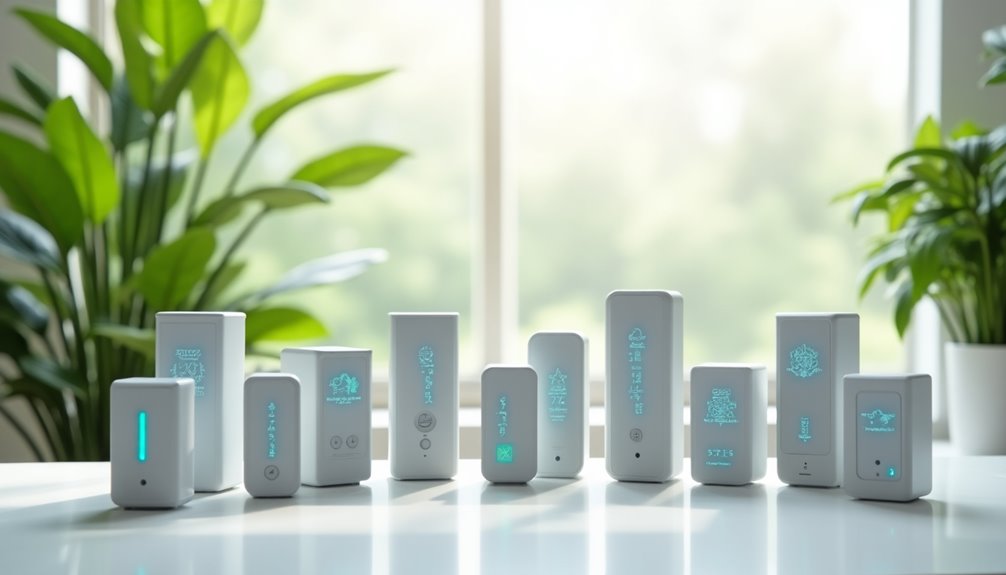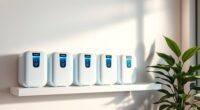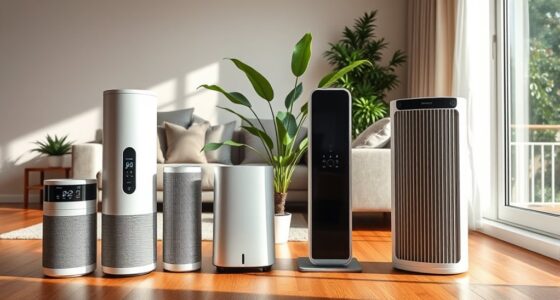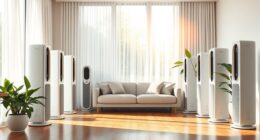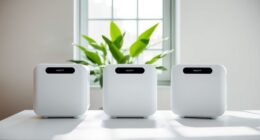If you’re looking for the best air quality monitors to keep your indoor air healthy, I recommend options that measure multiple pollutants like PM, CO2, VOCs, and formaldehyde, with real-time alerts and easy-to-use displays. Devices range from portable models to smart home compatible units, some with advanced sensors for precise readings. To make the right choice, consider features like connectivity, calibration, and design. Keep going, and you’ll discover more options tailored to your needs.
Key Takeaways
- Consider multi-parameter devices measuring PM, CO2, VOCs, formaldehyde, and radon for comprehensive indoor air quality monitoring.
- Look for high-precision sensors like laser or NDIR technology to ensure accurate and reliable readings.
- Choose monitors with user-friendly displays, real-time alerts, and app connectivity for easy data tracking and trend analysis.
- Prioritize portable, stylish designs with long battery life for flexible indoor, outdoor, or travel use.
- Evaluate device features such as calibration options, external sensors, and smart integration to optimize air quality management.
Amazon Smart Air Quality Monitor – Know your air, Works with Alexa
Are you looking for an easy way to keep tabs on your indoor air quality without complicated setups? The Amazon Smart Air Quality Monitor is a compact, user-friendly device that tracks PM 2.5, VOCs, CO, humidity, and temperature. It works seamlessly with Alexa, providing real-time updates through color indicators and notifications. Setup is quick, even for non-experts, and it supports routines to automate air purifiers or fans when needed. With its sleek design and simple app integration, it offers practical monitoring and peace of mind. While not lab-grade, it’s an effective tool for maintaining healthier indoor environments effortlessly.
Best For: homeowners and Alexa users seeking an easy, non-intrusive way to monitor indoor air quality and automate air-related devices.
Pros:
- Easy and quick setup suitable for non-experts with seamless Alexa integration
- Monitors multiple air quality factors including PM 2.5, VOCs, CO, humidity, and temperature
- Provides real-time alerts and routines to automate air purification and ventilation
Cons:
- Not laboratory-grade, with variable accuracy compared to specialized monitors
- Calibration cannot be manually checked, and threshold adjustments are limited by interface constraints
- Logs temperature in Celsius, which may not suit all user preferences
13-in-1 Portable Air Quality Monitor
If you’re looking for a reliable way to monitor indoor air quality with ease, the 13-in-1 Portable Air Quality Monitor is an excellent choice. It detects formaldehyde (HCHO), TVOCs, PM 2.5, temperature, and humidity, giving you real-time data to identify issues quickly. The clear digital LCD display makes readings easy to interpret at a glance, whether you’re at home or in the office. Its portable design allows flexible monitoring of both indoor and outdoor environments, helping you make timely ventilation decisions. Plus, backed by strong customer support, it offers peace of mind and an effective way to maintain healthier air quality in any space.
Best For: individuals seeking a reliable and portable device to monitor indoor and outdoor air quality easily and accurately.
Pros:
- Provides real-time detection of formaldehyde, TVOCs, PM 2.5, temperature, and humidity for comprehensive air quality insights.
- Equipped with a clear digital LCD display for easy interpretation of readings at a glance.
- Compact and portable design suitable for use in homes, offices, and outdoor environments.
Cons:
- May require regular calibration for maintaining measurement accuracy over time.
- Limited to the specific pollutants and environmental factors it monitors, excluding other potential indoor contaminants.
- Battery life could be a concern during prolonged outdoor use without frequent recharging.
Amazon Smart Air Quality Monitor – Know your air, Works with Alexa
The Amazon Smart Air Quality Monitor is an excellent choice for anyone already using Alexa devices who wants real-time insights into their indoor air. It’s compact, measuring just 65x65x45mm, and tracks five key factors: PM 2.5, VOCs, CO, humidity, and temperature. It integrates seamlessly with Echo devices and the Alexa app, providing instant updates via voice or notifications. Setup is simple, and it supports auto calibration and self-cleaning. The device displays air quality with color-coded LEDs and allows routines for automatic responses, like turning on a purifier. While not lab-grade, it offers a practical, user-friendly way to monitor and improve your indoor air quality.
Best For: Alexa users seeking an easy-to-use indoor air quality monitor that provides real-time insights and automation capabilities.
Pros:
- Seamless integration with Echo devices and Alexa app for voice updates and notifications
- Compact design with straightforward setup and auto calibration features
- Monitors multiple air quality parameters, including PM 2.5, VOCs, CO, humidity, and temperature
Cons:
- Not lab-grade or highly precise; accuracy may vary compared to specialized monitors
- Limited ability to manually set exact thresholds for routines due to Alexa’s slider interface
- Celsius-only temperature logging and occasional slow response times may affect user experience
Professional Indoor Air Quality Monitor, 5-in-1 Portable Smart Air Quality Tester
A professional indoor air quality monitor like this 5-in-1 portable device is ideal for anyone who wants real-time insights into their environment, whether at home, in the car, or in the office. It detects CO2, HCHO, TVOC, temperature, and humidity, displaying clear data on a high-definition LED screen. Its compact design makes it easy to carry or place anywhere. Equipped with advanced sensors, it offers accurate readings, though some users note occasional inconsistencies. With simple operation, alarms, and long battery life, this monitor helps you maintain healthy indoor air, especially for children, pets, or allergy sufferers. It’s a practical, versatile tool for ongoing air quality awareness.
Best For: individuals, families, and professionals seeking real-time, portable monitoring of indoor air quality to ensure a safe and healthy environment.
Pros:
- Provides comprehensive 5-in-1 detection of CO2, HCHO, TVOC, temperature, and humidity with real-time data.
- Compact, lightweight design with easy portability for use at home, in cars, or outdoors.
- User-friendly interface with high-definition LED display and audible alarms for immediate alerts.
Cons:
- Occasional inconsistencies in sensor readings, especially with certain substances like dried acrylic paint.
- Limited battery life for extended continuous use, though some users experience longer durations.
- Sensor accuracy may vary depending on environmental conditions and specific substances tested.
BREATHE Airmonitor Plus: Smart Indoor Air Quality Monitor
For anyone seeking a thorough indoor air quality solution, the BREATHE Airmonitor Plus stands out with its 8-in-1 sensor system that tracks pollutants like PM1, PM2.5, PM10, CO2, TVOC, formaldehyde, as well as temperature and humidity. It uses high-precision laser sensors and NDIR CO2 technology for accurate, real-time data. Compact and portable, it’s perfect for testing multiple rooms or outdoor spaces. The device connects seamlessly to the free Breathe Tech App via Wi-Fi, offering trend analysis, alerts, and clear visual data. Overall, it provides extensive monitoring to help maintain a healthier indoor environment.
Best For: individuals seeking comprehensive and real-time indoor air quality monitoring to ensure a healthier living or working environment.
Pros:
- Offers 8-in-1 sensors for detailed tracking of pollutants, temperature, and humidity.
- Compact, portable design with a built-in battery and easy app connectivity for real-time data and trend analysis.
- Utilizes high-precision laser and NDIR sensors for accurate measurement of indoor air quality parameters.
Cons:
- Limited battery life of only 2-3 hours may restrict extended use without frequent recharging.
- Some users report discrepancies in measurement accuracy compared to other monitors.
- Lacks advanced features like Bluetooth connectivity and a detailed manual explaining sensor functions and thresholds.
Professional Indoor Air Quality Monitor with AQI Beep Alarms
If you’re serious about maintaining healthy indoor air, the Professional Indoor Air Quality Monitor with AQI Beep Alarms stands out as an ideal choice. It offers real-time detection of pollutants like PM1.0, PM2.5, CO2, VOCs, and formaldehyde, with instant alerts through seven AQI buzzers. Its HD color display makes data easy to read, and a simple one-button start simplifies operation. The device is portable, stylish, and versatile, suitable for homes, offices, cars, or outdoor use. With quick charging and reliable sensors, it helps you monitor air quality continuously, empowering you to create healthier environments effortlessly.
Best For: Homeowners, office workers, and outdoor enthusiasts seeking real-time, comprehensive indoor air quality monitoring with instant alerts and easy operation.
Pros:
- Provides accurate, real-time detection of multiple air pollutants including PM, CO2, VOCs, and formaldehyde.
- Features a large HD color display for clear readability and seven AQI alert buzzers for instant notifications.
- Compact, portable design suitable for various environments like homes, offices, cars, and outdoor settings.
Cons:
- Some users report discrepancies in temperature readings, which may be less accurate compared to specialized thermometers.
- Battery life of around 4-5 hours on a single charge may require frequent recharging for continuous monitoring.
- Slightly higher price point compared to basic air quality monitors, which may be a consideration for budget-conscious buyers.
Airthings 2960 View Plus Air Quality Monitor
The Airthings 2960 View Plus stands out as an excellent choice for homeowners who want detailed indoor air quality monitoring, especially those concerned about radon. It’s WiFi-connected, battery-powered, and features seven sensors, including radon, PM2.5, CO2, VOCs, humidity, temperature, and air pressure. Its electrochemical sensors deliver accurate readings, and the passive diffusion chamber effectively detects radon. The sleek, cable-free design includes a customizable eInk display for easy monitoring. With a battery life of around two years and support for multiple devices, it provides extensive, real-time insights to help keep your indoor air safe and healthy.
Best For: homeowners seeking comprehensive, real-time indoor air quality monitoring with a focus on radon detection and easy integration into smart home systems.
Pros:
- Accurate detection with electrochemical sensors and passive diffusion chamber for radon.
- Long-lasting battery life of approximately two years with minimal maintenance.
- User-friendly app with trend analysis, customizable display, and multi-room support.
Cons:
- Requires WiFi connection and app registration, which may concern privacy-conscious users.
- Some users report shorter battery life depending on settings and placement.
- Limited to indoor use within specified temperature and humidity ranges.
14-in-1 Indoor Air Quality Monitor with Temperature and Humidity Sensors
An indoor air quality monitor with temperature and humidity sensors offers a thorough solution for health-conscious individuals who want real-time data on their environment. This 14-in-1 device measures PM1.0, PM2.5, PM10, CO2, CO, TVOC, HCHO, temperature, and humidity, providing detailed insights through a clear 2.8-inch color screen. It alerts me instantly if pollution levels rise and connects to my smartphone for remote monitoring. Compact and rechargeable, it’s perfect for home, office, or travel use. I appreciate its quick detection and easy operation, though battery life can be limited. Overall, it’s a versatile tool to ensure a healthier indoor space.
Best For: health-conscious individuals and families seeking real-time comprehensive indoor air quality monitoring and alerts.
Pros:
- Measures 14 different air quality parameters, including PM, gases, temperature, and humidity, providing detailed insights.
- Supports remote monitoring via smartphone app, enabling trend tracking and alerts outside the device’s vicinity.
- Compact, portable, and rechargeable, making it suitable for various environments like home, office, or travel.
Cons:
- Limited battery life (~6 hours), requiring frequent recharging for continuous use.
- Some users report sensor calibration issues and inconsistent readings compared to other devices.
- Short power cords and manual illustrations of low quality can affect ease of use and setup.
16-in-1 Indoor Air Quality Monitor with Display and Alerts
For anyone serious about maintaining a healthy indoor environment, the 16-in-1 Indoor Air Quality Monitor with Display and Alerts offers extensive real-time data on multiple pollutants and conditions. It detects nine key parameters, including CO2, PM levels, HCHO, TVOC, temperature, humidity, and AQI, with high-precision sensors and a clear 7-inch LED display. The device provides instant alerts via seven different buzzers, so you’re immediately notified of any concerning changes. Its user-friendly controls, adjustable brightness, and simple time and unit settings make monitoring straightforward. Overall, this monitor delivers exhaustive, accurate data and timely alerts to help you keep your indoor air safe and healthy.
Best For: individuals and families committed to maintaining a safe and healthy indoor environment through comprehensive air quality monitoring.
Pros:
- Detects 9 key indoor air quality parameters with high-precision sensors for accurate real-time data.
- Offers instant alerts via multiple buzzers, allowing quick response to pollutant changes.
- User-friendly with adjustable display brightness, easy time and unit settings, and a clear 7-inch LED screen.
Cons:
- External sensors require careful handling and should be protected from perfumes or strong odors to maintain accuracy.
- The device may be more complex for users unfamiliar with technical monitoring equipment.
- Limited to indoor use; not suitable for outdoor air quality assessment.
SAF Aranet4 Home Indoor Air Quality Monitor
Looking for an easy-to-use, portable air quality monitor that provides real-time insights into CO2, temperature, and humidity? The SAF Aranet4 Home is perfect. It’s wireless, battery-powered, and features a sleek e-ink display with color-coded alerts, making it simple to interpret data at a glance. Its NDIR sensor guarantees precise CO2 measurements, while the app lets you view, analyze, and export historical data easily. With a long battery life of up to four years and Bluetooth connectivity, it’s ideal for home, office, or travel use. Although it doesn’t measure VOCs or particulate matter, it’s a reliable, user-friendly tool for maintaining healthy indoor air quality.
Best For: individuals seeking a portable, easy-to-use indoor air quality monitor to track CO2, temperature, and humidity in home, office, or travel environments.
Pros:
- Precise CO2 measurement with NDIR sensor technology and clear visual alerts
- Long battery life of up to four years with battery-powered, cable-free design
- User-friendly app for data analysis, export, and historical trend review
Cons:
- Lacks sensors for VOCs, particulate matter, and other air pollutants
- Limited data storage duration on the app, with only 7 days without firmware updates
- Bluetooth-only connectivity restricts remote monitoring outside Bluetooth range
13-in-1 Indoor Air Quality Monitor with Wi-Fi
If you want thorough and real-time insights into your indoor air quality, the 13-in-1 Indoor Air Quality Monitor with Wi-Fi is an excellent choice. It tracks 13 critical metrics, like AQI, CO, CO₂, formaldehyde, TVOC, and particulate matter, with high-precision sensors for quick, accurate readings. The ultra-HD color screen makes data easy to interpret, while Wi-Fi connectivity allows remote monitoring and trend analysis via an app. Its sleek, compact design fits seamlessly into any space, and physical buttons make controls straightforward. Battery life supports portability, and alerts help you respond promptly to pollutants, making it a practical solution for healthier indoor environments.
Best For: individuals and families seeking comprehensive, real-time indoor air quality monitoring to ensure a healthier living or working environment.
Pros:
- Tracks 13 critical air quality metrics with high-precision sensors for accurate, rapid readings.
- Supports Wi-Fi connectivity for remote access, data logging, and trend analysis via a user-friendly app.
- Stylish, compact design with physical controls and an ultra-HD color display for easy, seamless integration into any space.
Cons:
- Battery life may be limited to 8-10 hours, requiring frequent recharging or constant plugging for continuous monitoring.
- Occasional lag in the app can affect real-time data access and responsiveness.
- Physical buttons and features might be less intuitive for some users during initial setup or adjustments.
11-in-1 Indoor Air Quality Monitor with Stand
The in-1 Indoor Air Quality Monitor with Stand stands out as an ideal choice for anyone seeking a portable, all-in-one device to monitor indoor air quality in real time. Its compact design, complete with a sturdy stand, makes placement versatile—perfect for homes, offices, or even vehicles. It measures 11 critical indexes, including AQI, CO2, particles, VOCs, temperature, and humidity, with lab-grade accuracy. The large backlit display and color-coded icons allow quick health assessments, while loud alarms alert me to hazardous levels. Thanks to its rechargeable battery, I can monitor continuously for up to 12 hours, making it both practical and reliable anywhere I need it.
Best For: individuals seeking a portable, comprehensive indoor air quality monitor to ensure a healthy environment at home, in the office, or on the go.
Pros:
- Provides real-time data on 11 critical air quality indexes with lab-grade accuracy.
- Compact, lightweight design with a sturdy stand, suitable for versatile placement.
- Features a large backlit display with color-coded icons and loud alarms for quick health assessment.
Cons:
- Requires periodic calibration and sensor restarting to maintain measurement precision.
- Battery life is limited to about 11-12 hours, which may necessitate frequent recharging.
- Auto-shutdown features need manual adjustment during calibration to prevent interruptions.
12-in-1 Portable Indoor Air Quality Monitor with Dual Chip and High Accuracy
This portable indoor air quality monitor is ideal for anyone who wants accurate, real-time data on pollutants and environmental conditions in various settings. It offers 12-in-1 measurement capabilities, including CO2, TVOC, particulate matter, humidity, and temperature. Its dual-chip system enhances data processing speed and accuracy (+/-0.5%), ensuring reliable readings. The sleek, modern design blends seamlessly into any space, and its rechargeable USB-C power supply allows for easy portability. With visual AQI indicators, alarms, and an intuitive display, I can quickly assess air quality and take action. Whether at home, work, or traveling, this device helps me maintain a healthier environment effortlessly.
Best For: health-conscious individuals, homeowners, and travelers seeking reliable, comprehensive indoor air quality monitoring for safer, healthier environments.
Pros:
- Accurate, real-time measurements of multiple pollutants and environmental factors (+/-0.5%)
- Stylish, minimalist design that seamlessly integrates into various spaces
- Portable with rechargeable USB-C power, suitable for multiple environments and on-the-go testing
Cons:
- Durability concerns may arise with prolonged use or frequent handling
- Limited brightness could affect visibility in very bright or dim settings
- Some users may find the setup or calibration process slightly complex at first
TEL UK Air Flow Monitor for Fume Hoods, 30 to 400 FPM Monitoring Range
Designed specifically for laboratory environments, the TEL UK Air Flow Monitor guarantees accurate airflow measurement within fume hoods across a range of 30 to 400 FPM. It provides reliable detection even during low-flow conditions, ensuring safety and compliance. The monitor features a durable sensor, simple calibration with pushbuttons, and multiple alarms—audible, visual, and relay—to alert you of low airflow or high sash position. It can record performance via RS-232 connection and is compatible with various models, including remote duct probes and graphic displays. Easy to install and maintain, it assures your fume hoods operate safely and efficiently at all times.
Best For: laboratories and facilities requiring precise airflow monitoring in fume hoods and biosafety cabinets to ensure safety and compliance.
Pros:
- Reliable and durable sensor ensures consistent performance.
- Easy calibration with pushbuttons simplifies setup and maintenance.
- Multiple alarm options (audible, visual, relay) enhance safety notifications.
Cons:
- May require optional accessories (e.g., proximity switch) for full feature set.
- Installation in ductwork with remote probes might be more complex.
- Limited to a monitoring range of 30 to 400 FPM, not suitable for very high airflow applications.
GoveeLife Smart Air Quality Monitor
If you’re looking for a compact, affordable air quality monitor that seamlessly integrates with smart home systems, the GoveeLife Smart Air Quality Monitor stands out as an excellent choice. It tracks PM2.5, temperature, and humidity with high accuracy, refreshing data every 2 seconds. Its sleek LED display shows real-time air quality levels, and it supports remote monitoring via Wi-Fi. Compatible with Govee’s smart appliances, it automates purifiers, humidifiers, and fans to maintain ideal indoor air. Easy to set up through the app, it offers 2-year data storage, making it perfect for home or office environments focused on healthier indoor air.
Best For: users seeking an affordable, compact, and easily integrated indoor air quality monitor for home or office environments with smart automation capabilities.
Pros:
- High accuracy in measuring PM2.5, temperature, and humidity with real-time data refresh every 2 seconds.
- Seamless integration with Govee’s smart appliances and compatibility with Alexa for automation.
- Compact, sleek design with easy setup and 2-year data storage for long-term monitoring.
Cons:
- Does not measure VOCs, CO2, CO, or other gases, limiting comprehensive air quality assessment.
- Lacks built-in battery; requires constant wired power via Type-C cable.
- No support for Matter protocol, which limits compatibility with some smart home ecosystems.
Factors to Consider When Choosing an Air Quality Monitor
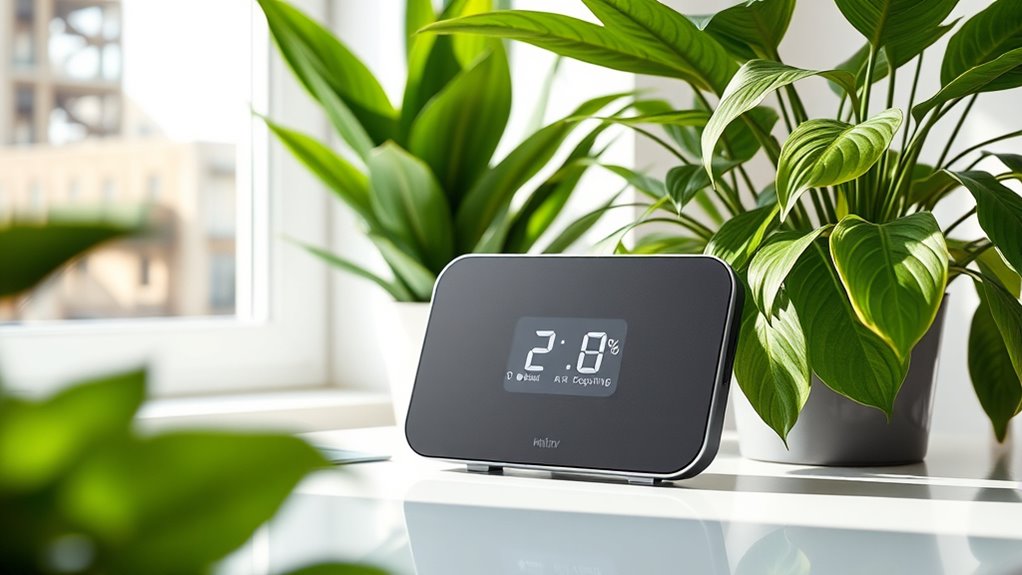
When selecting an air quality monitor, I look at sensor accuracy and the range it covers to guarantee reliable readings. I also consider what parameters it detects, how it connects to my devices, and whether the display is easy to read. Finally, portability and power options matter, especially if I want flexibility in where I use it.
Sensor Accuracy and Range
Choosing an air quality monitor requires paying close attention to sensor accuracy and measurement range, as these factors directly impact the reliability of the readings. Accurate monitors specify their measurement ranges for each parameter, like PM2.5 (0-500 µg/m³) or VOCs (0-500 points), ensuring they cover typical indoor levels. Sensor accuracy is given as a margin of error, such as ±10% for humidity or ±20 µg/m³ for PM2.5, which affects trustworthiness. Different sensors, like NDIR for CO2 or electrochemical for gases, have varying sensitivities and calibration needs, influencing measurement precision. The range indicates the maximum and minimum pollutant levels detectable, making it critical for monitoring both safe and hazardous conditions. High-quality sensors maintain accuracy over time, often with auto-calibration features.
Parameter Detection Capabilities
Selecting an air quality monitor involves evaluating its ability to detect specific pollutants relevant to your environment. Different monitors focus on various parameters like PM2.5, PM10, VOCs, formaldehyde, CO2, CO, and radon. The sensors used—such as NDIR for CO2, electrochemical for gases, or laser sensors for particulates—determine detection accuracy and sensitivity. Some models offer multi-parameter detection, providing a thorough view of indoor air quality, while others target specific pollutants like VOCs or CO2. The range and calibration of sensors affect how well the monitor detects pollutants at safe or hazardous levels. Choosing the right device depends on understanding which parameters matter most for your health and environment, ensuring you get reliable, meaningful data.
Connectivity Options Available
Connectivity options play a essential role in how effectively you can monitor and manage your indoor air quality. Wi-Fi-enabled monitors let you check air quality remotely through apps and can integrate with smart home systems, offering real-time updates. Bluetooth devices usually require you to be nearby, within about 6-8 meters, to view data on your phone or tablet. Wired options like USB or Ethernet provide stable data transfer but don’t support remote monitoring unless paired with additional network adapters. Some high-end monitors support multiple connectivity methods, giving you flexibility based on your environment and preferences. Consider how you want to access your data daily—whether remotely or locally—and choose a monitor that fits your tech setup and convenience needs.
Display and User Interface
A clear and user-friendly display is essential for effectively monitoring indoor air quality, as it allows you to quickly interpret data without confusion. An intuitive interface with easy-to-read visuals helps you understand air quality status at a glance. Digital screens that show real-time readings of parameters like PM2.5, VOCs, and temperature enable precise monitoring. Visual indicators such as color-coded alerts, smiley faces, or LED lights provide immediate understanding of air quality conditions without needing to analyze numbers. Adjustable brightness levels and customizable units (°C/°F) improve usability in different lighting environments. User-friendly controls, whether buttons or touchscreens, make it effortless to navigate the device, set preferences, and calibrate for ongoing accuracy. A well-designed display ensures you stay informed with minimal effort.
Portability and Power
When choosing an air quality monitor, considering how portable it is can make a big difference in how you use it. Some models weigh less than 150 grams and are small enough to fit in your pocket, perfect for on-the-go testing. Battery-powered options often last between 6 and 24 hours, letting you monitor air quality without being tethered to a power outlet. Many rechargeable monitors feature USB-C or micro-USB ports for quick charging, offering several hours of use on a single charge. Devices with built-in batteries eliminate the need for external cords, making them ideal for outdoor or temporary setups. Power options like plug-in adapters or portable batteries expand their versatility, allowing you to choose the best fit for your environment and testing needs.
Alarm and Alert Features
Choosing an air quality monitor with effective alarm and alert features is essential for timely responses to hazardous conditions. I look for monitors that provide real-time visual or auditory alerts, like beeps or flashing lights, so I can act immediately. Multiple alert options, including loud alarms and silent notifications, help me respond appropriately based on the severity. Adjustable alarm thresholds are important, allowing me to customize alerts to my safety standards or sensitivities. Some monitors warn for various pollutants simultaneously, like CO2, VOCs, and particulate matter, giving me a thorough view of air quality. Clear, easy-to-understand indicators, such as color-coded AQI levels or icon signals, help me quickly interpret air conditions and take swift action when needed.
Data Logging and Sharing
Effective air quality monitors come with data logging features that record historical air quality levels, allowing me to review trends over days, weeks, or months. I appreciate devices that support exporting data in formats like CSV or PDF, making it easy to share with health professionals or keep records. Cloud-based sharing is also a big plus, as it lets me access my air quality history remotely through mobile apps or web portals, providing thorough monitoring from anywhere. The frequency of data logging varies; some monitors record every few seconds, offering detailed insights, while others log less often, which may reduce granularity. Reliable connectivity, whether Wi-Fi, Bluetooth, or cellular, is essential for accurate data sharing. Internal storage or cloud services ensure my data stays safe and accessible whenever I need it.
Frequently Asked Questions
How Often Should I Calibrate My Air Quality Monitor?
You’re wondering how often to calibrate your air quality monitor. I recommend checking the manufacturer’s guidelines, but generally, calibrating every 3 to 6 months functions well. Regular calibration ensures accurate readings and reliable data, especially if you notice fluctuations or inconsistent results. If your monitor is used in a critical environment, more frequent calibration might be necessary. Staying on top of this helps keep your indoor air quality truly healthy.
Can These Monitors Detect Radon or VOCS Specifically?
Most air quality monitors can detect VOCs, which are common indoor pollutants, but not all are equipped to specifically measure radon. If radon detection is a priority, you’ll want a monitor with a dedicated radon sensor. I recommend checking the product specs carefully, as some advanced devices combine VOC and radon detection, giving you a thorough view of your indoor air quality.
Do All Monitors Support Smartphone App Integration?
Imagine a symphony where each instrument plays a vital role—I see monitors as the conductor, guiding your home’s air quality. Not all monitors support smartphone app integration, but many do, allowing you to keep an eye on your indoor environment from anywhere. I recommend checking product specs carefully, as features vary. Embracing a smart monitor helps you stay proactive, much like a conductor ensures harmony in a performance.
What Is the Typical Lifespan of Sensor Components in These Devices?
The typical lifespan of sensor components in air quality monitors usually ranges from 2 to 5 years. I’ve found that sensors can degrade over time, affecting accuracy. Regular calibration and timely replacements can extend their usefulness. Keep in mind, high-quality devices often have longer-lasting sensors. I recommend checking the manufacturer’s guidelines for specific lifespan details and maintenance tips to keep your monitor functioning accurately.
Are There Monitors Suitable for Allergy or Asthma Sufferers?
Alright, allergy and asthma sufferers, rejoice! Luckily, some monitors are tailored just for you. They track pollen, mold, VOCs, and humidity levels, giving you real-time alerts to keep symptoms at bay. I’ve found several that integrate seamlessly with smart home systems and provide detailed data. So, instead of suffering in silence, you can breathe easy knowing your air quality is actively monitored and improved.
Conclusion
Keeping your indoor air fresh is like tending a delicate garden—you need the right tools to nurture it. These monitors are your vigilant guardians, turning your space into a sanctuary of clean, healthy air. With just a glance, you can breathe easier, knowing your environment is in harmony. So, pick the one that sings to your needs, and let your home’s air be as vibrant and pure as a spring breeze.
